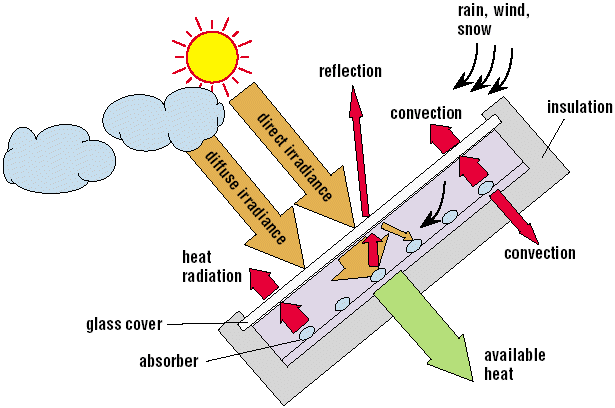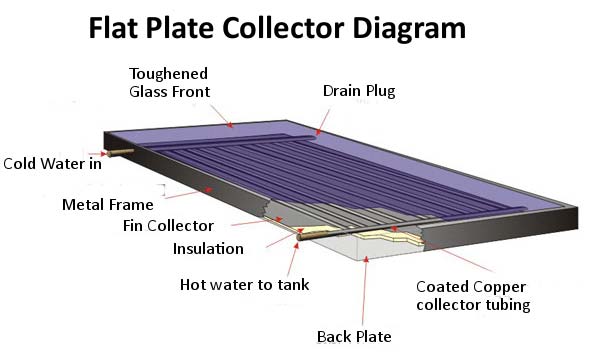What is a flat plate collector? What are the advantages and disadvantages of flat plate collector? What are the application of a flat plate collector? Have you been looking for answers to this question? If yes, then you have gotten to the right place.

This article will be explaining all you need to know about flat plate collector together with its advantages and disadvantages.
Flat plate collector is a type of solar thermal energy. Flat plate collectors have become more efficient, less expensive and widely available in the past decades. Flat plate collectors are advantageous because they are highly affordable compared to other types of solar thermal installations and relatively easy to maintain.
It also uses steel and glass equally as much as it uses reflectors. The flat plate collector makes use of pre-existing roof or wall coverings that are either made of steel or glass that are usually pre-painted on the outside.
Unlike other types of solar collectors, the flat plate collector is not a single panel but rather a rigid frame with frames to hold the glass and steel plates together. The rigid frames need to be installed exactly in line with the roof or wall for it to function properly.
A flat-plate collector is a simple solar thermal system using air as the heat-transfer fluid with sunlight being the energy source.
What Is A Flat Plate Collector?
A flat-plate collector (FPC) is a device to collect solar energy and transform it into thermal energy (low-grade energy) by using water as a working fluid. It is a heart of solar thermal devices that has many applications in a medium temperature range ≅100 °C from domestic to preheating to industrial sectors.
The heat-transfer fluid, i.e. the working fluid, is typically water but other fluids are available such as air, both of which have been used in some FPCs. Air is an air-based working fluid in flat plate collectors with a high surface area and low specific heats.
Flat plate collectors have no optical concentrator and the collector area as well as the absorber area is numerically the same. A flat plate collector is placed at a location in a position such that its length aligns with the line of longitude and is suitably tilted towards south if located in a northern hemisphere to have maximum collection.
FPCs use the solar radiation as a heat source, either direct or diffuse radiation (solar flux). The reflectors in FPCs are required to concentrate the sunlight through a deep and narrow window onto a single plane or plane of thin glass cover while utilizing the maximum amount of collecting elements.
The flat-plate collector has been found to be the most efficient method of solar energy collection and is widely used in residential, agricultural, commercial and industrial sectors.
A well engineered flat plate collector delivers heat at a relatively low cost for a long duration. FPCs are designed using linear technology to maximize the energy conversion, increasing energy efficiency.
In contrast to parabolic troughs and other forms of concentrator with curved reflectors, flat plate collectors require linear panels that have a tailored shape for concentrating sunlight onto a single plane.
The FPC is an easy installation because the bare-roof and wall surface does not need to be heated or insulated for it to work effectively. A FPC allows for greater utilization of roof space, increasing the heating and cooling potential of the roof/wall assembly.
Before going to the advantages and disadvantages of flat plate collector, let’s take a look at the principle of flat plate collector.
Principle Of Flat Plate Collector

A flat plate collector is a type of solar thermal system that uses sunlight as its source of energy and transfers this solar energy as heat to either air, liquid or solid materials, as required.
Flat plate collectors are made up of steel plates, glass sheets and reflectors that are employed to collect and transfer sunlight’s thermal energy into either heating air or heating liquid (water).
The principal behind a flat collector is simple. If a metal sheet is exposed to solar radiation, the temperature will rise until the rate at which energy is received is equal to the rate at which heat is lost from the plate; this temperature is termed as the ‘equilibrium’ temperature.
The absorbed energy is directly converted into thermal energy and is used for heating water or space. The flat plate collector basically consists of a number of thin film solar collectors mounted on the roof or wall surface. It uses the thermal mass of heated water tanks to store produced heat throughout the day so that it can provide warm water in the evening.
For heat with withdrawal from the system, the equilibrium temperature must decrease, since no useful heat can be extracted at he maximum equilibrium temperature at which the collection efficiency is zero.
The other extreme condition is when the flow of liquid is so flat that the temperature rise is very small; in such a case although the losses are small and the efficiency of the heat collection approaches 100 percent, yet no useful heat can be extracted.
Now that we have had a good knowledge about what a flat plate collector is and the principle of a flat plate collector, let’s dive into the advantages and disadvantages of flat plate collector.
Advantages And Disadvantages Of Flat Plate Collector
Here, we will be looking at the advantages and disadvantages of flat plate collection but firstly, we will discuss about the advantages and the later its disadvantages.
Advantages Of Flat Plate Collector
Some of the advantages of flat plate collector are as follows:
1. Easy To Manufacture
The flat plate collector is a simple design and can be easily manufactured. Unlike other solar thermal devices which are costly, the cost of flat plate collector is less when compared to other materials such as copper.
Flat plate collectors are also cheaper to manufacture than curved surface concentrators because of the linear design.
A FPC is used to collect and store solar energy on the roof surface or wall surface and then convey it through pipes to various appliances, space heating, water heating or air conditioning system.
2. Low Cost
The flat panel heat exchanger system is quite cheap and easy to install compared with a conventional solar systems that cost more and takes more time for installation also making it difficult for homeowners to install them themselves.
3. Simple And Easy To Operate.
The flat plate collectors are very easy to operate because they don’t have complex parts inside the panels. In addition, without any electric elements, flat plate collectors are also simple to install and can be easily operated by only one person.
Disadvantages Of Flat Plate Collector
Some of the disadvantages of flat plate collector are as follows:
1. Unstable Performance
Unlike other solar panels, the performance of flat plate collectors is very unstable, affecting their energy output. The performance of FPCs has been found to be affected by many factors like weather conditions, geographical location and local climatic conditions.
2. Insufficient Storage
As the FPC is only designed to produce a limited amount of thermal energy, its storage capacity is also significantly less than that of other solar thermal systems. Due to this, the electricity produced from the system can sometimes be less than the electricity used by the system.
The flat plate collector’s storage facility is also linked with higher temperatures and is affected by low irradiance. This results in continuous loss at the end of each day which makes it impossible for the system to recover even 50-60 percent of its produced energy.
Applications
The flat plate collector has become more and more popular all over the world because of its simplicity, ease of installation and low cost.
A FPC can also be used to heat ground water or other underground medium. It is also effective in using as an evaporative cooler and a humidifier by using an evaporator tube that can be connected to a tank of water with water source such as rainwater.
Many commercial buildings or homes use flat plate collectors in the office spaces, restaurants, schools, and apartment buildings for air conditioning or heating purposes by connecting them directly to the building’s HVAC systems.
They are also used in food processing plants where they can be used for drying fruits and vegetables.
Other common applications of flat plate collectors are solar water heaters, systems for district heating, the heating of air or liquid in industrial processes and solar space heating.
Conclusion
In conclusion, flat plate collectors are one of the most common solar thermal technologies and can be highly effective in providing sustainable energy for heating space and water. It is simple to construct and operate, however, it has some disadvantages that includes unstable performance and limited efficiency.
It’s important to identify your needs while looking at the various types of solar collectors. Some flat plate heaters can be connected directly to the building’s HVAC system while others require a separate electrical supply that needs to be monitored often depending on your specific application.
As mentioned earlier, there are many benefits associated with using a flat plate collector as an alternative energy source for heating water or space. But given the amount of choices available in the market, it is difficult to make an informed decision.
So, before you look into buying one, do a thorough research and check the pros and cons associated with each type making sure that you have all your needs met.










